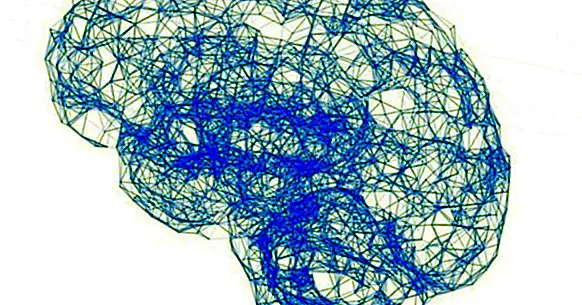The theory of the intelligence of Raymond Cattell
The theory of the intelligence of Raymond B. Cattell It is one of the most influential in this field of study.
This multifactorial and hierarchical theory proposes that there is a general factor of intelligence that depends on the genes and manifests itself in multiple cognitive abilities, which factor analysis groups in two factors: the fluid intelligence and the crystallized .
- Related article: "Fluid Intelligence and Crystallized Intelligence: what are they?"
Cattell's theory of intelligence

Raymond Bernard Cattell (1905-1998) was an English psychologist who achieved fame because of his Psychometric research on the human mind , which focused particularly on personality and intelligence. From the factorial analysis, in which he was a pioneer, he developed two very influential theories about these psychological constructs.
Other topics that interested Cattell include motivation, emotion, learning, creativity, academic and professional orientation and social interaction. However, he is known above all for his factorial theory of personality and the 16PF questionnaire, which was derived from his model and remains one of the most used today.
In the work of this author is very remarkable the influence of the statistician Charles Spearman , which used the factorial analysis even before Cattell. In particular, Cattell's theory of intelligence is derived from Spearman's two-factor theory, which argued that there is a general cognitive factor (g) that explains lower-level skills.
John L. Horn, disciple of Cattell, later developed his theory, focusing on fluid intelligence and crystallized intelligence; the same did John B. Carroll. This is the reason why the theory that we will describe in this article is often called "Cattell-Horn-Carroll theory" .
- Maybe you're interested: "The theories of human intelligence"
Cognitive skills of the first order
Through factor analysis, Cattell identified a series of primary factors that structure intelligence . He paid special attention to the first two, which he identified with fluid intelligence and crystallized intelligence; We will discuss these two factors in detail in the next section.
1. Fluid reasoning
This aptitude consists of the flexible and deliberate use of mental operations to adapt to new situations and solve problems in which you do not have experience. It is also known as fluid intelligence and includes processes such as inductive and deductive reasoning, the formation of concepts, classification and identification of relationships.
2. Understanding-Knowledge
The understanding-knowledge factor, which corresponds to crystallized intelligence, is the knowledge accumulated during life and is influenced by the sociocultural context, as well as by the educational level. It is fundamentally based on verbal and procedural information learning .
3. Quantitative knowledge
Quantitative knowledge is defined as the quantity and depth of numerical and mathematical knowledge, both declarative and procedural. It is acquired mainly through formal education, so it is associated with crystallized intelligence.
4. Suitability for reading and writing
This factor is similar to the previous one, although in this case the material is not mathematical but linguistic. Skills such as reading comprehension, the ability to spell, the knowledge of languages and the reading speed are related to this aptitude.
5. Short-term memory
For Cattell short-term memory is the ability to retain and manage the information obtained at the last minute, approximately; therefore, in current terms, it would be more appropriate to think of operational memory when conceptualizing this factor.
- Related article: "Types of memory: how memory stores the human brain?"
6. Long-term storage and recovery
This aptitude it is associated with long-term memory and also with operational , since it includes the subfactors that allow the consolidation of information in the memory, as well as its recovery and management. Among the related factors we find free recall, fluency in the association of ideas, ease of naming and creativity.
- Related article: "Work (operational) memory: components and work"
7. Visual processing
Cattell defined visual processing as the aptitude for generate, store, recover and modify images . This factor includes other lower order such as visual memory, visualization, detection of visual patterns, spatial scanning and mental rotation.
8. Auditory processing
The tasks that involve the perception of sounds and the functioning of the auditory system are related to this ability. Among the subfactors that make up auditory processing are discrimination of frequencies and tones, resistance to sound distortion and memory for sound patterns.
9. Processing speed
This factor is defined as the ability to carry out easy or overlearned cognitive tasks in an efficient way. It is associated with different types of material; For example, both the speed of calculation and the speed of reading and writing depend on this ability, but so do the reasoning speed and the perception speed.
10. Reaction time and decision
The tenth first order aptitude described by Cattell is the capacity to issue answers or make decisions quickly in the face of the appearance of certain stimuli. It weighs in the time of choice between alternatives, in the speed of semantic processing and in the mental comparison, among other lower factors.
Fluid and crystallized intelligence
Cattell gave great importance to two of the primary cognitive skills : Understanding-Knowledge and Fluid Reasoning . It considered that these two factors, that denominated respectively "crystallized Intelligence" and "fluid", explained the rest in good measure. This dichotomy is still very popular in the psychology of intelligence.
According to this author and many subsequent studies, fluid intelligence has an important genetic-hereditary component , is influenced by the physical state, decreases in old age and is involved in the resolution of new problems. This type of intelligence includes skills such as spatial reasoning, memory and processing speed.
By cons, crystallized intelligence is derived from learning ; consequently, it is more influenced by culture and socialization than fluid, and is not as affected by age. Verbal skills depend mainly on crystallized intelligence, and executive functions are also influenced by it.
The analysis of Cattell They also identified an underlying general factor both fluid intelligence and crystallized intelligence: historical fluid intelligence, which is basically equivalent to the "g" factor described by Spearman and many later authors. This nuclear cognitive factor has a biological character and is related mainly to fluid intelligence.
Therefore, and despite the fact that Cattell's theory of intelligence is usually classified as a multifactorial model, it is also true that it has a relevant hierarchical component. Fluid intelligence influences different skills, many of which also weigh in a primary factor related to learning (crystallized intelligence).



















